Are Frogs Poisonous to Dogs?

Almost all frogs (and toads) are harmless to people and dogs. There are a few species, mostly toads, that pose an immediate danger to dogs. Knowing the dangers and signs associated with frog poisoning is a good way to protect your family pet!
In this article, I’ll show you which species are particularly dangerous to dogs and where they’re located in the world. After that, I’ll list the symptoms of toad poisoning and finally, I’ll guide you on what you can do if your dog gets ahold of a poisonous frog!
Table of Contents
The Potential Dangers of Frogs
There are two main dangers associated with interactions between dogs and amphibians. The most obvious, and the main reason you’re reading this post, is the poison. The second danger is that frogs are a choking hazard.
1. Amphibian Toxins
Note the difference between poison and venom. Poison is a harmful substance that is ingested or absorbed. Venom is a harmful substance that is injected via fangs, stringers, etc.
Nearly all amphibians produce some type of toxin on their skin. The toxin is not injected – it has to be absorbed via touch or ingested. Due to this, frogs are considered “poisonous”. That doesn’t mean all amphibians are harmful to dogs (or humans). In fact, most aren’t harmful at all.
Fun fact: There are a few known venomous frogs! Their “venomous” delivery method comes in the form of tiny spikes atop their skulls!
Amphibians carry these toxins at different locations on their bodies. Having said that, most toxins are located on the back or in glads on the side of their head. The toxins are used as a defense mechanism. It’s meant to keep predators away.
Bufotoxins (Toads)
Bufo is short for “Bufonidae” which is a family containing true toads. Bufotoxins, as you might have guessed, are toad toxins! Bufotoxins are typically contained in “parotoid glads”, which are large, warty-looking bumps located behind a toad’s eyes. See the picture below.
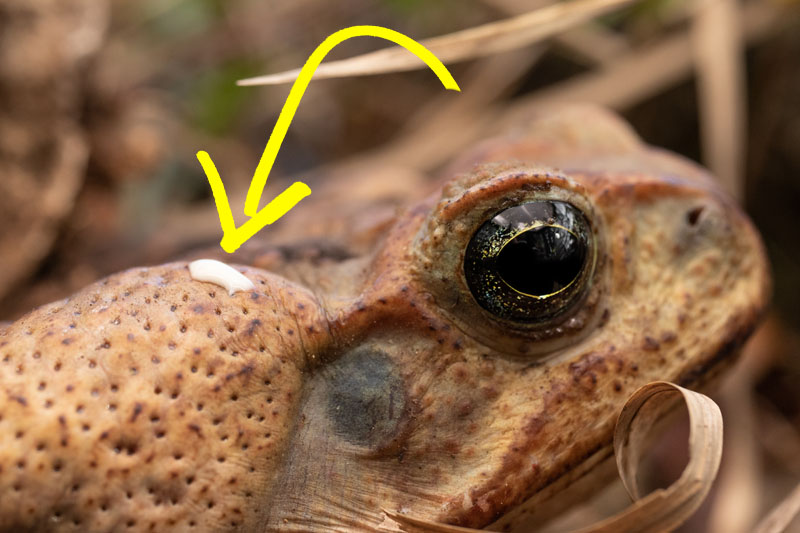
Parotoid glands contain a sticky, alkaloid substance that looks similar to milk. You typically won’t see bufotoxin unless it is squeezed from the parotoid glands.
Simply holding a toad yields little risk of touching the toxin. Like I mentioned, it has to be squeezed out. This can happen if a dog, cat, or small animal were to bite a toad!
Batrachotoxin (Dart Frogs)
If you’re reading this post and don’t know what a poison dart frog is, you probably don’t need to worry about them. Why? Well, if you live in a part of the world that has poison dart frogs you likely already know about them!
That’s because batrachotoxin from poison-dart frogs is potentially deadly to humans and definitely lethal to dogs!
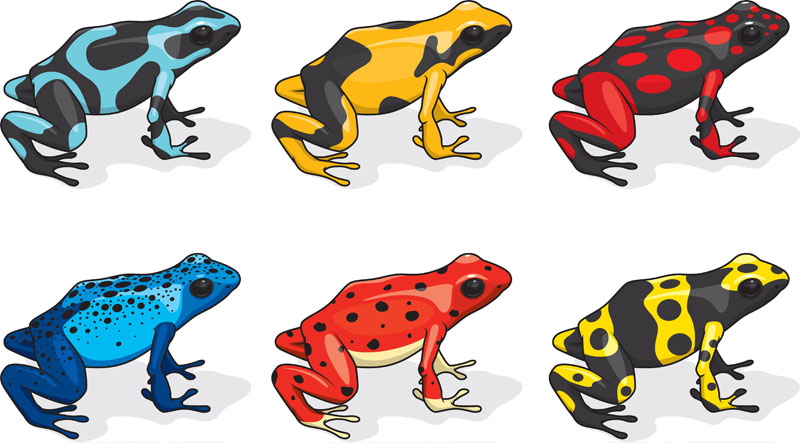
Dart frogs are native to dense tropical and subtropical forests in Central and South America. A few species inhabit parts of Hawaii as well.
If you’re planning a trip with your dog to one of these countries, I recommend doing research on dart frogs!
Some sightings in Florida have been noted but, as far as I know, there are no established populations. Hawaii has an established population of Green and Black Poison Dart Frogs (Dendrobates auratus). See this PDF for more details.
Tetrodotoxin (TTX)
Tetrodotoxin is a powerful neurotoxin found in members of the Taricha genus, which is actually a type of salamander. While salamanders clearly aren’t frogs, they’re in class amphibia and worth mentioning here.
There are four species in the Taricha genus found in the United States. The California newt, Sierra newt, Red-bellied newt, and Rough-skinned newt. They’re found along the West Coast, in parts of California, Nevada, Washington, and Oregon. For more information, read this post about poisonous salamanders.
2. Choking Hazard
As if the possibility of toad poisoning wasn’t enough, there is also a risk of choking!
Frogs and toads are small and seem enticing for a dog; especially a puppy. Frogs jump long distances while toads tend to hop. Frogs are hard to catch and toads, while they’re surprisingly fast, won’t outrun a fast dog!
Should your dog attempt to eat a large toad, there is a chance it can get stuck in its throat.
Related: Poisonous Frogs: A Complete Guide
Dangerous Frog & Toad Species
The majority of people reading this post are in the United States, Canada, Australia, or United Kingdom. These regions of the world are home to a number of different species, both frogs and toads.
The good news is that aren’t many species to worry about! Aside from dart frogs, there are just two that possess toxins capable of harming dogs! Both are toads and you can learn more about them in the sections below.
Cane Toad
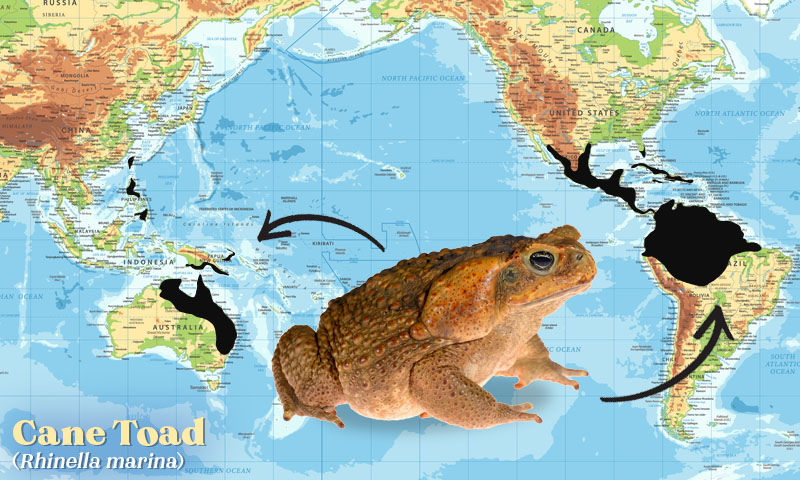
The Cane Toad is a large, terrestrial true toad (Bufonidae family). They’re also known as “Marine Toads” and they are found in the Americas and Australia.
In the United States, cane toads inhabit the Southern parts of Texas and Florida, as well as parts of Hawaii [1]. In Australia, they’re found throughout the Northeastern regions. See the image above for a map of their locations around the world.
It’s worth noting that at the time of writing this, there are approximately 94 species within the Rhinella genus (including the cane toad). Most of which are found throughout Mexico, Central American, and South America. They’re large toads that are similar in appearance to Cane Toads!
Colorado River Toad
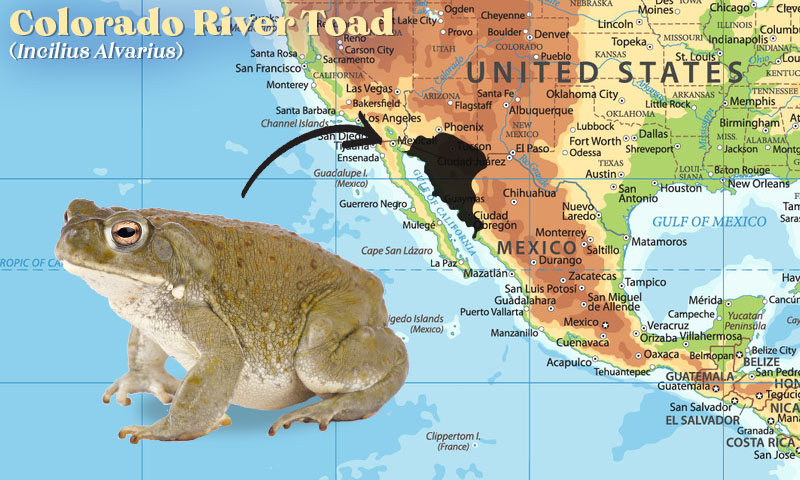
The Colorado River Toad (Incilius alvarius) is also known as the “Sonoran Desert Toad”. This is another species that is dangerous for dogs! They’re large toads, growing up to 7.5-inches in length.
Poison from a Colorado River Toad is potent enough to kill a dog [2]. This toad’s toxins are in the hallucinogenic family and they’re very dangerous to small animals.
Colorado River Toads only inhabit a small part of Arizona and New Mexico in the United States. Refer to the picture above. It has a map marking the known living areas.
Common Toads
While Cane Toads and Colorado River Toads are two of the most threatening toads known to dogs, there are a few others to know about! They’re known simply as “Common Toads”.
- Common Toad (Bufo bufo) – United Kingdom
- American Toad (Anaxyrus americanus) – United States
Both of these species have a wide distribution in the regions they inhabit. They’re not as threatening as the two toads mentioned above, but they still grow quite large and can, in the right circumstance, be harmful to small dogs!
Symptoms of Toad Poisoning in Dogs
At this point, you know which frogs and toads are the most dangerous. Now let’s take a look at what happens to dogs when they’ve been poisoned. Here are the most common symptoms:
- Drooling, salivation, or foaming at the mouth
- Redness in gums
- Rapid heart beat
- Convulsions
- Paralysis
Each toxin is different, depending on the toad. However, most of them cause a rapid heartbeat. This causes your dog to feel uneasy. They will begin acting differently than usual. Drooling and redness of the gums is one of the most common indicators of toad poisoning. Finally, large doses of bufotoxins may cause convulsions or paralysis.
Bufotoxin poisoning can lead to heart failure in dogs. So, it’s important to know what to do if your dog comes into contact with a poisonous amphibian!
What to do if your dog licks, bites, or swallows a toad
Let me preface this by saying I am not a veterinarian! Contact your vet! If you suspect your dog has been poisoned by a toad, there are two things you can do!
- Take your dog to a veterinarian. Give them a call on your way so they know what’s going on.
- Clean your dog’s gums and the roof of their mouth with a rag or piece of cloth.
Bufotoxin is a sticky, white substance. It might still be lingering in your dog’s mouth. Lift up their lip and wipe along their gums with a rag, towel, or something similar. If possible, wipe the roof of their mouth too!
Most vets don’t recommend using a water hose to clean out your dog’s mouth because it can lead to more complications like pneumonia. Opt for using a rag or piece of cloth to wipe the toxins out. You could do this before or on the car ride to the veterinarian!
TLDR; Are Frogs Dangerous to Dogs?
There are several frogs in the US, UK, Canada, and Australia that are dangerous to dogs. Two types of toads that are especially harmful are the Cane Toad and Colorado River toad. See the pictures above for a map of the areas they inhabit.
Poison dart frogs are especially harmful but they’re mostly found in Central and South America.
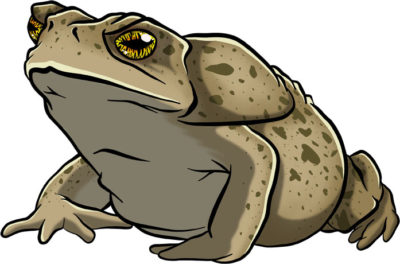
Aside from the harmful toxins found on frogs, they also pose a choking hazard!
If you suspect your dog has been poisoned there are two things you can do. The first is to get your dog and go to the vet. Call them on the way so they know what’s going on. The second is to take a rag and clean your dog’s mouth.
Bufotoxin, the poison found in most toads, is a sticky white substance. It might still be in your dog’s mouth. Wipe along their gums and, if possible, the roof of their mouth.
I hope this helps! Remember, most frogs and toads are harmless to small pets like cats and dogs. The best thing to do if you see your dog playing with a frog is to intervene. The frog doesn’t like it and your pet could get hurt. Help the frog (or toad) get to a safe location, away from your dog.
Featured photo credit seregraff / Adobe Stock
References
- Zug, G. R., & Zug, P. B. (1979). The marine toad, Bufo marinus : a natural history resumé of native populations. Smithsonian Contributions to Zoology, 284, 1–58. https://doi.org/10.5479/si.00810282.284[↩]
- Staff, A. D. M., Mus, P. W., Arizona-Sonora Desert Museum Staff, Phillips, S. J., Comus, P. W., & Arizona-Sonora Desert Mus. (2000). A Natural History of the Sonoran Desert. Amsterdam University Press.[↩]
